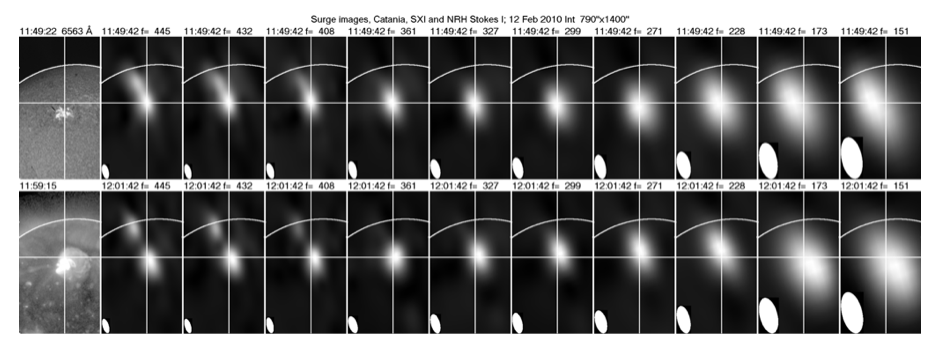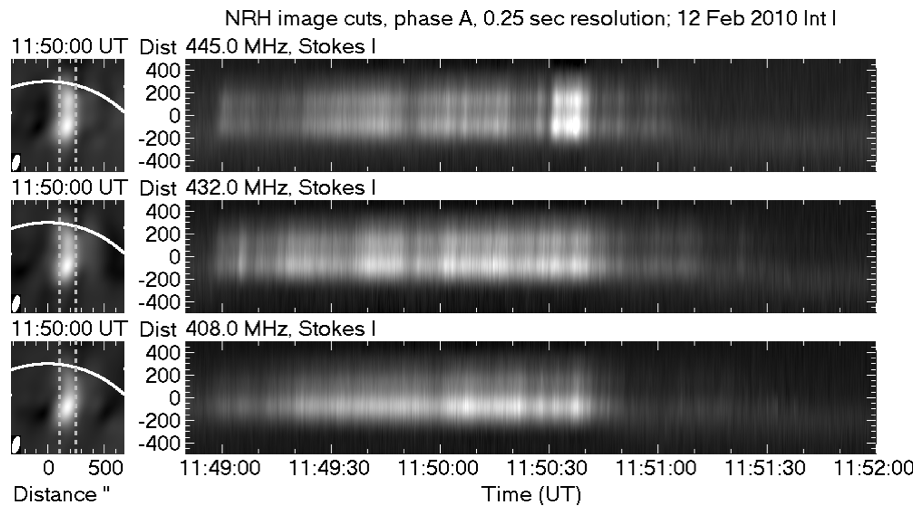Practically all solar phenomena observed in radio wavelengths have their counterpart in other regions of the electromagnetic spectrum. Metric solar bursts are an exception to the above statement. Although we have a basic understanding of their origin, some of their counterparts in other spectral ranges have not been identified, with the exception of the so called “radio CMEs”. This is apparently because metric bursts result from coherent plasma emission, which has no observable signature outside the radio range. Here we report the detection of surge-associated metric emission that occurred after the end of the bulk of a large radio burst that occurred on February 12, 2010 near the central meridian (N25, E11), and was described by Alissandrakis et al. 2021 (Paper I, see also CESRA nugget) . 
Figure 1. NRH images in total intensity of the surge at all ten frequencies during the first (top) and the second (bottom) phase of the event. The white arc marks the solar limb, the insert shows the NRH beam (resolution), while the crosshair is placed at the maximum of the lower source at 445 MHz during the first phase. The images are normalized so that the maximum intensity at each frequency is white and the minimum is black, with a linear scale. An Hα image from Catania and a long exposure SXR image from SXI are given for reference in the left column (from Alissandrakis et al. 2022).
Observations and Analysis
We used images from the Nançay Radioheliograph (NRH) at ten frequencies with a cadence of 250 ms and a spatial resolution of 1.20′ by 1.80′ at 432 MHz, dynamic spectra from the ARTEMIS-JLS radiospectrograph and CALLISTO; light curves from GOES, Hα images from Catania, soft X-ray images from the GOES Soft X-ray Imager (SXI), EUV images at 304 Å with a cadence of 10 min from STEREO SECCHI A and B and coronagraph images from STEREO COR1, with a cadence of 5 min. Seen from STEREO-A, the event was very close to the E limb, whereas it was near the W limb for STEREO-B. No EIT data were available during the event. The three-dimensional position of the surge features was computed from triangulation of STEREO A and B images at 304 Å and, from that, the projection of the surge on the plane of the sky, as seen from the Earth.
Results
Radio emission from the surge was detected by the NRH during two intervals: from 11:49 to 11:51 UT (phase A) and from 12:00 to ~13:00 UT (phase B). There was no trace of surge emission either in Hα or in SXR. We further note that in both phases two sources appear in the high-frequency NRH images where the resolution is higher (Figure 1); moreover, during phase B the upper source is clearly displaced upwards, compared to phase A, which is apparently a result of the expansion of the surge. Expansion velocities of the order of 150 km/s were measured based on the NRH and STEREO data. The size and position of the source are markedly different in the two lowest frequencies, indicating different structures or different emission mechanisms. 
Figure 2. Stokes I cuts (intensity as a function of time and position along the surge), at full time resolution, for 445.0, 432.0, and 408.0 MHz, during phase A of the surge. Zero position is at the middle of the cut. The width of the cuts is marked on the images at left (from Alissandrakis et al. 2022)
Short-scale time variations were found during both phases of the surge. An example is shown in Figure 2, which gives images (cuts) of the intensity as a function of time and position along the axis of the surge during the phase A. Interestingly, the variations in the upper lower and upper source are highly correlated, with a slight time delay, which appears as an inclination of the features in the Figure. Taken at face value, this delay translates to propagation at superluminal speed. However, when the geometry is properly taken into account (left panel of Figure 3), a more plausible explanation is that this delay is due to scattering of radiation from the lower source by the upper source.
NRH images showed a high degree of circular polarization, confirmed by dynamic spectra; the latter also showed spikes and pulsations. All these point towards type IV-like plasma emission from the fundamental. The positions of the NRH lower source, from 327 to 435 MHz, computed for emission at the fundamental, projected very close to the base of the surge on the sky plane as seen from STEREO-A (right panels of Figure 3).

Figure 3. Left: NRH source positions on a plane perpendicular to the sky plane (open circles). A and B refer to the corresponding phases of the emission. The limits of the 304Å surge derived from triangulation are also plotted in red for reference. Dotted lines with arrows point towards the observer. The black arc marks the solar limb. Right: Computed NRH source positions from 327 to 435 MHz (red filled circles) projected on the sky plane as seen from STEREO-A, on top of base-difference 304 Å images near phase A (left) and during phase B (right). Higher-frequency sources are at lower radial distances. (from Alissandrakis et al. 2022),
Conclusions
We reported the detection of metric radio emission from a surge, associated with a secondary energy release during the late phase of the M9-class flare of February 12, 2010, that was previously analyzed in Paper I. This is the first time that direct imaging of a surge is reported. The detection of surge-associated emission adds one more manifestation to the list of flare-associated metric radio emissions.
The NRH images showed that the surge occurred in two phases and consisted of two sources. Short-scale time variations appeared in both, with a slight delay suggesting superluminal velocities; a proper consideration of the geometry revealed that scattering of radiation from the lower source by the upper source is the most likely explanation.
The observed high degree of circular polarization, as well as the presence of spikes and pulsations in the dynamic spectrum, could be accommodated by plasma emission from the fundamental. Moreover, radio source positions computed under this mechanism are consistent with the surge position as seen from STEREO-A. Hence, we consider type IV-like plasma emission with a low intensity gyrosynchrotron component as the most plausible mechanism.
Based on a recent paper by Alissandrakis, C. E., Patsourakos, S., Nindos, A., Bouratzis, C., Hillaris, A., 2022, A&A, 662, A14. https://doi.org/10.1051/0004-6361/202243169
References
Alissandrakis, C. E., C. E., Nindos, A., Patsourakos, S., Hillaris, A, 2021, A&A, 654, A112. doi:10.1051/0004-6361/202141672 (Paper I)
*Full list of authors: Costas Alissandrakis, Spiros Patsourakos, Alexander Nindos, Costas Bouratzis and Alexander Hillaris
